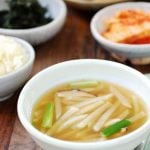Easy Korean rolled omelette made simply with seaweed (gim), which adds a distinct flavor and a beautiful contrast of color.

What is gyeran mari?
Gyeran mari (계란말이), literally translated to egg roll or rolled eggs, is Korean rolled omelette. It’s usually served as a side dish and highly popular as a lunch box item. Gyeran mari is typically made with one or two types of chopped vegetables commonly with scallions and carrot, but there are many variations.
Here, it’s made with gim (dried seaweed sheet – aka nori). The gim adds a distinct seaweed flavor to the rolled egg and a beautiful contrast of color.
It’s not that hard to make gyeran mari. You just need to know the basics. Simply pour a portion of the egg mixture into a thin layer. When the egg is set but still wet, fold it with a spatula and keep rolling. Pull the rolled egg to a side, and add more egg mixture to the open space to repeat.
I made this one a little simpler by skipping the steps used to create more layers. You can use this quicker method to make gyeran mari with other ingredients as well.
However, if you want to try more layers, pour the egg mixture into the pan in 2 batches with 1-1/2 sheets of seaweed. First add ⅔ of the egg mix, use 1 sheet, spread some egg mix over the seaweed, roll, move it to one side. Pour the remaining egg on the other side, and add 1/2 sheet of gim. Watch the technique here.
Tips for making rolled omelette
- Preheat the pan until it feels hot when you place your hand 2 to 3 inches above the bottom of the pan.
- Leave a little bit of egg mixture to spread over the seaweed sheet as glue.
- Be patient! Cook the eggs over gentle heat. If the heat is too high, you’ll end up with tough eggs that will break when folded. If you don’t cook the eggs enough, the rolled egg will be runny inside.
- Use both hands to roll, each holding a spatula, a spoon or a pair of chopsticks.
- Use a small skillet if you want your rolls to be thick.
Practice makes it better! Don’t give up even if it doesn’t turn out perfect.
More gyeran mari recipes
Gyeran mari (rolled omelette)
Gyeran mari (rolled omelette) with bell peppers
For more Korean cooking inspirations, follow along on YouTube, Pinterest, Twitter, Facebook, and Instagram.

Equipment
- medium size non-stick pan (9 to 10-inch)
Ingredients
- 3 eggs (see note 1)
- 1 sheet gim (김) - dried seaweed (aka nori) See note 1
- pinch salt
- oil for the pan
Instructions
- Crack and beat the eggs, in a bowl with a spoon or a fork, until the yolks and whites are blended well with no visible strings of whites. Stir in a pinch of salt. (If using, stir in chopped vegetables.)
- Add a teaspoon of vegetable oil to a medium size non-stick pan and distribute the oil evenly using a napkin or paper towel. Preheat over medium low heat, until it feels hot when you place your hand 2 to 3 inches above the bottom of the pan.
- Add ⅔ of the eggs to the pan. Swirl it around to cover the pan. (Reduce the heat or raise the pan away from the heat, for a little while, if the egg is cooking too fast.) See note 2.
- When the egg is set but the surface is still wet, add a sheet of gim. Pour the remaining egg over the gim and swirl the pan around to spread the egg mixture evenly.
- When the egg surface is set again, using a spatula, lift one end of the egg (about 1-1/2 inch) and fold it over to the other side. Quickly lift the folded part and fold it again. (The egg should be slightly wet while being folded, or the roll will become loose when sliced.)
- Repeat the process until an egg log is created.
- Remove from the pan and let cool for about 5 minutes. Slice the egg into thick, even pieces (3/4 to 1-inch thick).
Notes
- You can use 4 eggs with 1-1/2 sheets of gim to make a thicker roll, using the technique below.
- If you want to try more layers, pour the egg mixture into the pan in 2 batches with 1-1/2 sheets of seaweed. First add ⅔ of the egg mix, use 1 sheet, spread some egg mix over the seaweed, roll, move it to one side. Pour the remaining egg on the other side, and add 1/2 sheet of gim. Watch the technique here.
This gyeran mari with seaweed recipe was originally posted in April 2012. I’ve updated it here with new photos, more information and minor changes to the recipe.































